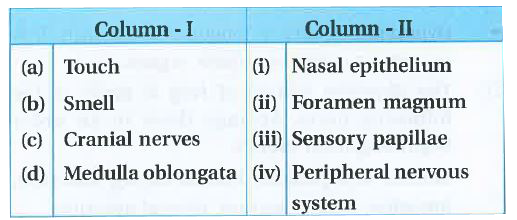Match the followings.
Root typesExamplesa. Annulatedi. Turmericb. Noduloseii. Ipomoeac. Tuberousiii. Dahliad. Fasciculatediv. Indian spinache. Beadedv. Ipecacvi. RadishSolution in Tamil
a−ivb−iic−id−iiie−vi
a−ib−iic−iiid−ive−v
a−ivb−iiic−iid−ie−vi
a−vb−ic−iid−iiie−iv
The correct Answer is:D
a−vb−ic−iid−iiie−iv
Topper's Solved these Questions
- VEGETATIVE MORPHOLOGYBOOK - FULL MARKSCHAPTER - VEGETATIVE MORPHOLOGYEXERCISE - ADDITIONAL QUESTIONS SOLVED (II.Very Short Answer Type Questions)
61 Videos
- VEGETATIVE MORPHOLOGYBOOK - FULL MARKSCHAPTER - VEGETATIVE MORPHOLOGYEXERCISE - ADDITIONAL QUESTIONS SOLVED (III.Short Answer Type Questions)
27 Videos
- VEGETATIVE MORPHOLOGYBOOK - FULL MARKSCHAPTER - VEGETATIVE MORPHOLOGYEXERCISE - TEXTBOOK ACTIVITIES SOLVED
3 Videos
- TRENDS IN ECONOMIC ZOOLOGYBOOK - FULL MARKSCHAPTER - TRENDS IN ECONOMIC ZOOLOGYEXERCISE - Additional Questions Solved ( Answer the following questions.)
99 Videos
Similar Questions
Define morphology.
View SolutionStudy of morphology is important in taxonomy. Why?
View SolutionCollection of medicines prepared from root, stem, leaf of organic plants.
View SolutionWhat is Economic Zoology?
View SolutionName the part modified for food storage in the following (a) carrot (b) Radish (c) Potato (d) Dahlia (e) Turmeric (f) Sweet potato
View Solutionవేర్ల ద్వారా శాఖీయోత్పత్తి జరిపే మొక్కbr i) డాలియాbr ii) ముల్లంగిbr iii) క్యారెట్br iv) క్యాబేజిbr
View SolutionThe correct order of attachment is 1) Leaf () a) Dahlia, radish 2) Stems () b) Ranapala, Bignonia 3) Roots () c) Turmeric, Potato
View SolutionConversion of leucoplasts to chloroplast is found in (I) Tubers of Radish (II) Potato tubers (III) Fruit of Tomato (IV) Maize kernels
View SolutionMatch the followings.
RootsExplanationa. Tuberousi. Roots swelling occurs only near the tipsb. Fasciculatedii. Roots swell at regular interavlsc. Beadediii. Roots are in cluster from the base of the stemd. Noduloseiv. Roots are swoollen without any definite shapev. Roots have ring - like swelling at regula intervals
View SolutionMatch the following. {:("Root types","Examples"),("a. Foliar root","i. Tinospora"),("b. Haustorial root","ii. Vanda"),("c. Photosynthetic root","iii. Bryophyllum"),("d. Epiphytic root","iv. Cuscuta"):}
View SolutionWhich type of modification of root is found in following plants:
(i) Turnip (ii) Banyan tree (iii) Rhizophora (iv) Dahlia (v) Cuscuta
View SolutionMatch the followings and choose the correct answer. (A) (a - ii), (b - iii), (c - iv), (d - i) (B) (a - iii), (b - ii), (c - iv), (d - i) (C) (a - i), (b - iii), (c - ii), (d - iv) (D) (a - ii), (b - iv), (c - iii), (d - i)
View SolutionMatch the following with reference to cockroach and choose the correct option. (A) (a - iii), (b - iv), (c - ii), (d - i) (B) (a - iv), (b - iii), (c - ii), (d - i) (C) (a - iv), (b - ii), (c - iii), (d - i) (D) (a - ii), (b - iv), (c - iii), (d - i)
View SolutionMatch the followings and choose the correct answer.

(A) (a - iii), (b - i), (c - ii), (d - iv)
(B) (a - ii), (b - i), (c - iv), (d - iii)
(C) (a - iii), (b - iv), (c - ii), (d - i)
(D) (a - iii), (b - i), (c - iv), (d - ii)
View SolutionMatch the two columns: (A) (I-A),(II- B), (III- D), (IV- C) (B) (I-B), (II-A), (III-D), (IV - C) (C) (I- A), (II-B), (III-C), (IV- D) (D) (I- D), (II- A), (III-C), (IV-B)
View Solution
